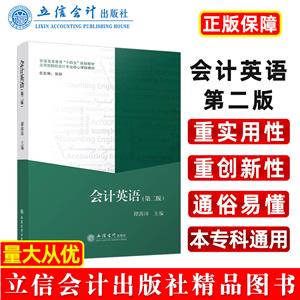-
>
中医基础理论
-
>
高校军事课教程
-
>
思想道德与法治(2021年版)
-
>
毛泽东思想和中国特色社会主义理论体系概论(2021年版)
-
>
中医内科学·全国中医药行业高等教育“十四五”规划教材
-
>
中医诊断学--新世纪第五版
-
>
中药学·全国中医药行业高等教育“十四五”规划教材
会计英语(第二版) 版权信息
- ISBN:9787542974228
- 条形码:9787542974228 ; 978-7-5429-7422-8
- 装帧:平装-胶订
- 册数:暂无
- 重量:暂无
- 所属分类:>>
会计英语(第二版) 本书特色
本书依据国际财务报告准则(InternationalFinancialReportingStandards,IFRSs)进行编写,我国财政部也已颁布了与IFRSs趋同的《企业会计准则》,因此本书具有较强的实用性和创新性,能让在校学生接触*前沿的会计理论知识。本书参考了国际上比较受欢迎的英文原版教材,使用地道、简练的英语进行诠释,采用国内读者熟识的结构,通俗易懂。
会计英语(第二版) 内容简介
本书分别从会计导论、会计等式和复试记账、会计循环、资产、负债、权益、财务报表几个角度阐述国际会计准则的基础内容。本书每个章节都由六部分组成:学习目标(learningobjectives)、正文、重点词汇(keyterms)、难点注释(notestothetext)、课堂自测题(self-testquestions)和课后习题(exercises)。其中,“重点词汇”方便学生进行课前自学;“难点注释”便于学生深入理解章节重点;“课堂自测题”可以让学生及时检测学习成果、强化重点知识;“课后习题”可以让教师借助此部分习题合理安排上课内容,讲练结合,同时也利于学生课后对本章节的知识点进行巩固。
会计英语(第二版) 目录
会计英语(第二版) 作者简介
谭茜玮,郑州升达经贸管理学院,副教授,会计学院教师,本科、研究生均毕业于英国高校,从教近10年,主要讲授“会计专业英语”“ManagementAccounting”和“FinancialAccounting”等双语课程。近5年共主持河南省社科联、郑州市社科联、民办教育协会以及校级课题共14项(其中教育厅高校人文社会科学研究一般项目1项),参与课题共13项,独立发表论文共11篇(其中核心论文2篇),主编教材1部,专著1项。
- >
二体千字文
二体千字文
¥22.4¥40.0 - >
罗曼·罗兰读书随笔-精装
罗曼·罗兰读书随笔-精装
¥20.3¥58.0 - >
上帝之肋:男人的真实旅程
上帝之肋:男人的真实旅程
¥19.3¥35.0 - >
我与地坛
我与地坛
¥16.5¥28.0 - >
史学评论
史学评论
¥22.7¥42.0 - >
中国历史的瞬间
中国历史的瞬间
¥16.7¥38.0 - >
回忆爱玛侬
回忆爱玛侬
¥23.0¥32.8 - >
诗经-先民的歌唱
诗经-先民的歌唱
¥19.9¥39.8
-
4.23文创礼盒A款--“作家言我精神状态”
¥42.3¥206 -
4.23文创礼盒B款--“作家言我精神状态”
¥42.3¥206 -
一句顶一万句 (印签版)
¥40.4¥68 -
百年书评史散论
¥14.9¥38 -
1980年代:小说六记
¥52.8¥69 -
中图网经典初版本封面-“老人与海”冰箱贴
¥20¥40





















